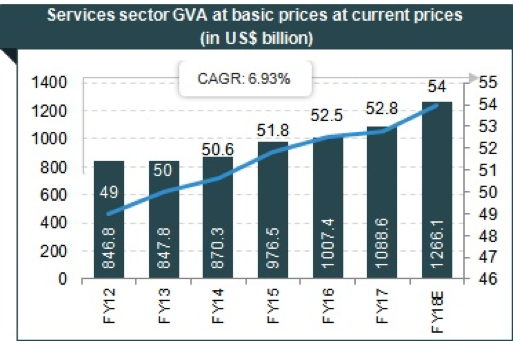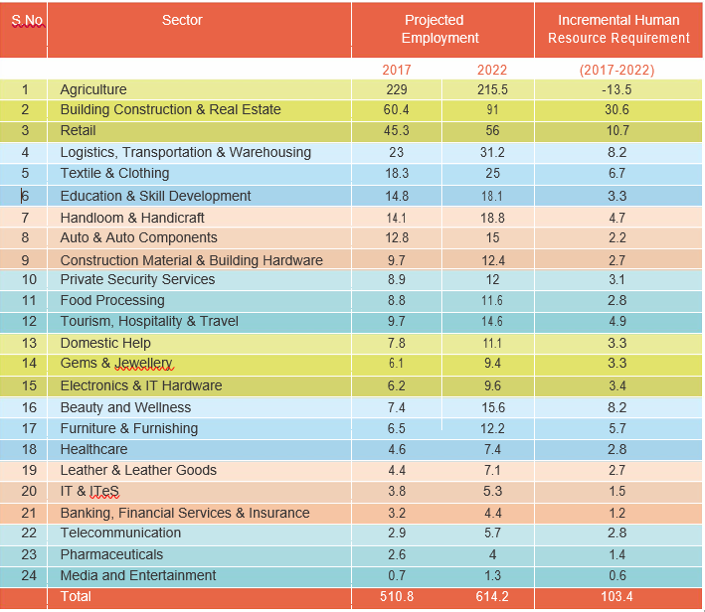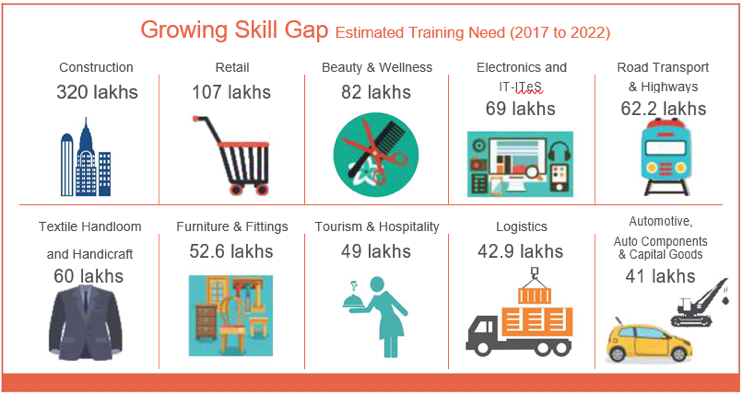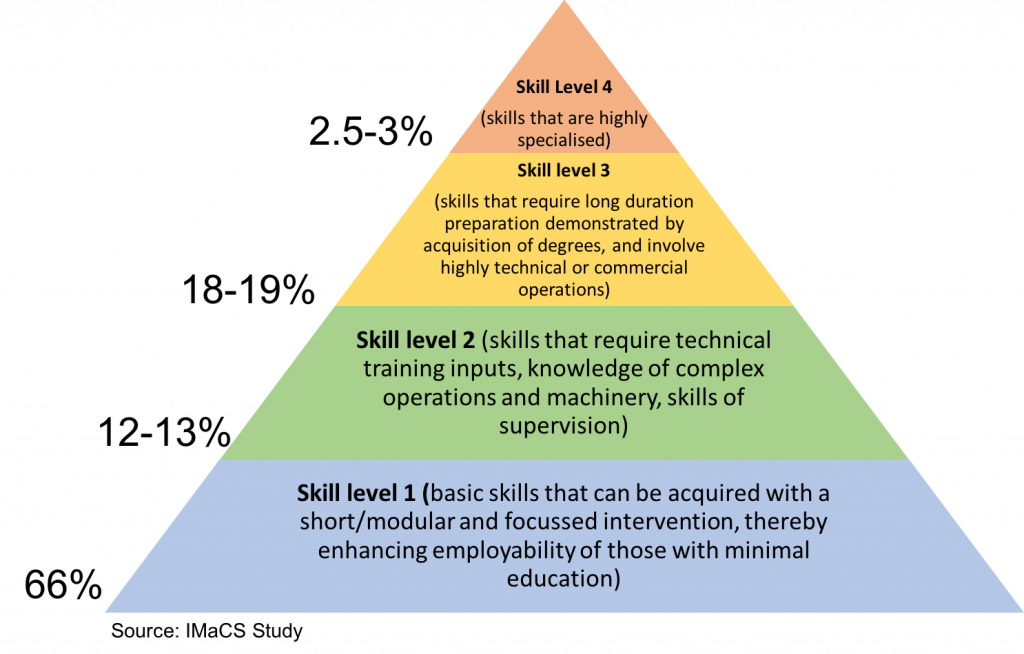According to a CII report “India Services Sector: A Multi-Trillion Dollar Opportunity for Global Symbiotic Growth” (2017), the Indian service sector is the fastest growing service sector in the world contributing more than 60% to the economy and accounts for 28% of employment. A shift in workforce dynamics from agriculture, hitherto the dominant employer, is already underway.
What are the in-demand skills needed by the next generation of workers in the service sector and is there an opportunity for VET and apprenticeships to fill the skill gap?
To address these questions and more we will be taking you through a series of blog posts over the coming weeks. Each week we will explore opportunities in a new high growth service sector from the point of view of vocational skills. Part I of the series gives an overview of opportunities that exist in the Service sector. We will cover analysis of specific sectors in terms of opportunities they provide in the apprenticeship space, starting with Retail & E-commerce given its prominent position in the services space and the changing retail landscape. Other key growth sectors, among others, that we will be covering in subsequent weeks are Beauty & Wellness, Travel & Hospitality, and Logistics.
Service Sector Calling-The Opportunities in The Challenges
India’s services sector GVA grew at a CAGR of 6.93% to US$ 1,266.1 billion in FY18 from US$ 846.8 billion in FY12.1


The 2016-17 Annual Report2 commissioned by the National Skill Development Corporation (NSDC) @MSDESkillIndia have identified incremental human resource requirement of 103.4 million across 24 high priority sectors between 2017-22. The negative employment growth rate in agriculture by 2022, as seen below, is indicative of a workforce migration to other sectors; for instance, 28.6% of the country’s population in 2016-17 was employed in the services sector.3
Break Up of Incremental Human Resource Requirement across 24 Sectors (Estimates in millions)


High growth sectors in terms of human capital requirement and skill gap have been identified as:


However, a major challenge as indicated by a FICCI/ Ernst & Young (2012) study4 states that India is one of the top countries globally struggling to supply suitably trained workers. Clearly, there is no demand constraint. An IMACS5 study found the greatest skilling requirement was at the bottom of the pyramid at 66% in Skill level 1, where skill acquisition by the least educated represents an enormous employment creation potential.


With a gaping skill gap between demand and supply, it has become imperative to shine a sharp light on the urgent need for suitably skilled workers on a nationwide scale to generate millions of jobs, all the more so in the service sector. Skilling the unskilled and the inadequately skilled to ride the service sector wave and reap maximum benefits both for the worker and the economy is indeed the need of the hour.
Enabling Environment
We find several positive factors that can take employment in the service sector to the next level. The average working Indian will be 29 years old by 2020 as against 37 in China and the US, 45 in Europe and 48 in Japan.6 A young and energetic workforce is a major advantage to skilling and upskilling initiatives. The present government has taken significant steps in recognition of the vital role of VET and apprenticeships in the next chapter of economic development.
- The Ministry of Skill Development and Entrepreneurship was formed in 2014 specifically to steer national level skill initiatives
- As of 2016-17, 40 Sector Skill Councils have been established as a joint partnership between industry, labour force and academia to identify and fill gaps in priority and high growth sectors2
- National Apprenticeship Promotion Scheme (NAPS) to train 500 million people by 2022
- Skill India to train over 40 crore people by 2022
- Skill Acquisition and Knowledge Awareness for Livelihood Promotion Programme (SANKALP) and Skill Strengthening for Industrial Value Enhancement (STRIVE) were introduced in 2017 to provide vocational training to 35 million youth and improve the quality of TVET education provided in ITIs
- Digital India to bring about a transformation in digital infrastructure and capabilities to boost connectivity, online and digital services, e-commerce and e-governance
- The Pradhan Mantri Kaushal Vikas Yojana (PMKVY) to train 10 million youth with vocational skills
The Way Forward
Apprenticeships in India have traditionally focused on the manufacturing sector and have been quite prescriptive in nature. Moreover, employers found various clauses and requirements in the Apprenticeship Act (1961) and its various amendments over the years to be regressive and hard-lined such as an obligation for every employer to have apprentices, punitive penalties including imprisonment for breach of rules under the Act, among others. However, sweeping changes to the Act in 2014 have made it much more conducive and industry-friendly. Introduction of new trades under the Act and expansion of the scope of existing trades have given due consideration that apprenticeships in India should no longer be limited to any particular sector. As an alternate career option apprenticeships are still in its infancy in India compared to model nations such as Germany. The journey has started in India too and it is up to all stakeholders to carry the baton forward to make a real difference to the huge skilling problem facing the country.
We begin our analysis of opportunities in vocational and skill-based employment in India’s service sector with Retail & E-commerce.
References:
1Services Sector in India, Jun 2018, India Brand Equity Foundation
2Annual Report 2016-17, Ministry of Skill Development & Entreprenuership, GoI
3Services report, Apr 2018, India Brand Equity Foundation
4Knowledge paper on skill development in India-Learner first, Sep 2012, FICCI, Ernst & Young
5 Skill Development Initiatives and Measures in India- A Study Report, 2013, India Brand Equity Foundation
6 Economic Survey 2011-12, GoI













